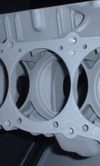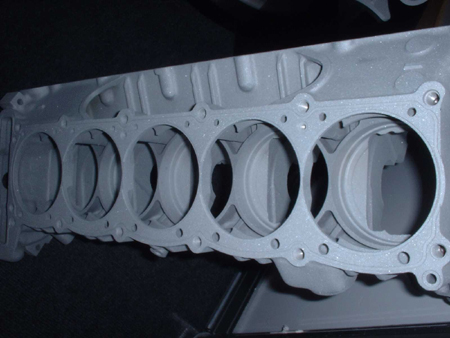Rapid prototyping
 Having seen the extremely brisk pace of development in rapid prototyping methods over the past decade, it strikes me that this is a technology that stands to revolutionise the way we will come to make many parts for race engines.
Having seen the extremely brisk pace of development in rapid prototyping methods over the past decade, it strikes me that this is a technology that stands to revolutionise the way we will come to make many parts for race engines.
For a number of years there have been rapid prototype parts run on racecars on everything from Formula Student to Formula One. The method offers a way to have small numbers of complex parts made quickly and in a cost-effective manner, with the costs of design changes in many cases being restricted only to those relating to the design itself.
There are many polymer materials that can be used not only for ancillary parts on engines (covers for example), but in manufacturing (wax cores for investment castings) and engine development rigs (transparent covers for rigs studying oil motion, for example). However, the applications of rapid prototyping using the available polymer materials are limited in race engines owing to stress and temperature constraints.
For a number of years there have been metallic materials used for rapid prototyping, and the technology is now producing truly impressive parts with excellent mechanical properties. A RET-Monitor article (www.ret-monitor.com/articles/898/advanced-materials) looked at some of the available materials, and previously one of them, the aluminium alloy Al-Si10-Mg, was singled out for brief examination (see www.ret-monitor.com/articles/828/new-application-of-aluminium-alloy/). The list of available metals is expanding and already encompasses a number of materials of interest to the engine designer, including aluminium alloys, high-strength steels, titanium and high-temperature materials.
An application for which rapid prototyping is finding increased use in racing, in the field of metals processing, is in the production of sand castings, where it is now possible to 'print' sand cores and outer moulds directly for major structural castings such as blocks and heads. In one such method, the rapid prototyping machine produces a layer of sand that is subsequently and selectively treated with a binding agent in the relevant areas. In another, sand that is pre-coated with resin is fused using laser sintering. At the end of the process, the untreated sand can be easily removed to reveal the solid sand tools.

Owing to the fact that cores produced by such methods do not need to be withdrawn from core boxes, it is possible to model castings such that the cores need no draft angle, and they can be more complex than ever before, with many kinds of finely detailed internal features in the casting now possible. A secondary benefit is that your casting CAD model needs far less post-processing at the foundry than before.
The method is still developing, and it is not at the stage yet where it can economically replace traditional methods of producing castings for anything other than very short runs of prototype parts. However, an important advantage is the rapidity with which the first cast parts can be produced using these methods.
Owing to the fact that production of core boxes and machining of moulds is no longer required, the production times can be impressively short. Of course, none of this precludes the requirement for careful qualification of the castings to ensure integrity and any necessary casting development.
Fig. 1 - Rapid prototyping of casting tooling makes production of complex structural parts, such as this racing cylinder block, much quicker (Courtesy of Vitesse Engineering Services)
Written by Wayne Ward